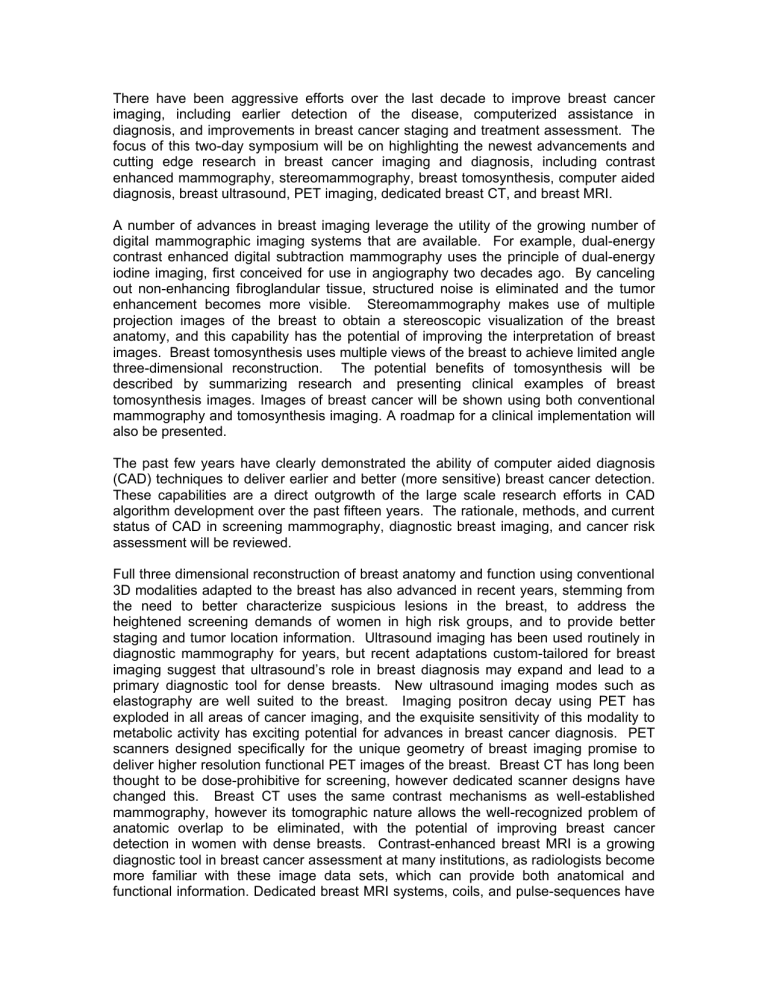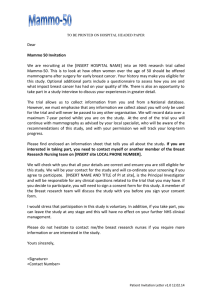There have been aggressive efforts over the last decade to... imaging, including earlier detection of the disease, computerized assistance in

There have been aggressive efforts over the last decade to improve breast cancer imaging, including earlier detection of the disease, computerized assistance in diagnosis, and improvements in breast cancer staging and treatment assessment. The focus of this two-day symposium will be on highlighting the newest advancements and cutting edge research in breast cancer imaging and diagnosis, including contrast enhanced mammography, stereomammography, breast tomosynthesis, computer aided diagnosis, breast ultrasound, PET imaging, dedicated breast CT, and breast MRI.
A number of advances in breast imaging leverage the utility of the growing number of digital mammographic imaging systems that are available. For example, dual-energy contrast enhanced digital subtraction mammography uses the principle of dual-energy iodine imaging, first conceived for use in angiography two decades ago. By canceling out non-enhancing fibroglandular tissue, structured noise is eliminated and the tumor enhancement becomes more visible. Stereomammography makes use of multiple projection images of the breast to obtain a stereoscopic visualization of the breast anatomy, and this capability has the potential of improving the interpretation of breast images. Breast tomosynthesis uses multiple views of the breast to achieve limited angle three-dimensional reconstruction. The potential benefits of tomosynthesis will be described by summarizing research and presenting clinical examples of breast tomosynthesis images. Images of breast cancer will be shown using both conventional mammography and tomosynthesis imaging. A roadmap for a clinical implementation will also be presented.
The past few years have clearly demonstrated the ability of computer aided diagnosis
(CAD) techniques to deliver earlier and better (more sensitive) breast cancer detection.
These capabilities are a direct outgrowth of the large scale research efforts in CAD algorithm development over the past fifteen years. The rationale, methods, and current status of CAD in screening mammography, diagnostic breast imaging, and cancer risk assessment will be reviewed.
Full three dimensional reconstruction of breast anatomy and function using conventional
3D modalities adapted to the breast has also advanced in recent years, stemming from the need to better characterize suspicious lesions in the breast, to address the heightened screening demands of women in high risk groups, and to provide better staging and tumor location information. Ultrasound imaging has been used routinely in diagnostic mammography for years, but recent adaptations custom-tailored for breast imaging suggest that ultrasound’s role in breast diagnosis may expand and lead to a primary diagnostic tool for dense breasts. New ultrasound imaging modes such as elastography are well suited to the breast. Imaging positron decay using PET has exploded in all areas of cancer imaging, and the exquisite sensitivity of this modality to metabolic activity has exciting potential for advances in breast cancer diagnosis. PET scanners designed specifically for the unique geometry of breast imaging promise to deliver higher resolution functional PET images of the breast. Breast CT has long been thought to be dose-prohibitive for screening, however dedicated scanner designs have changed this. Breast CT uses the same contrast mechanisms as well-established mammography, however its tomographic nature allows the well-recognized problem of anatomic overlap to be eliminated, with the potential of improving breast cancer detection in women with dense breasts. Contrast-enhanced breast MRI is a growing diagnostic tool in breast cancer assessment at many institutions, as radiologists become more familiar with these image data sets, which can provide both anatomical and functional information. Dedicated breast MRI systems, coils, and pulse-sequences have
lead to advances in breast MRI resolution and sensitivity. The current status of breast
MRI as both a diagnostic and screening tool will be assessed.
The symposium on new advances in breast imaging will provide current researchers and clinical practitioners a solid overview of the exciting areas in breast imaging research in the post-digital mammography era, and will highlight the advantages and future potential of each of the techniques presented. Each speaker in this symposium is an active researcher in the topic that they will present. A panel discussion will take place at the end of each day’s presentations, so that audience members can pose questions and challenges to the panelists.



